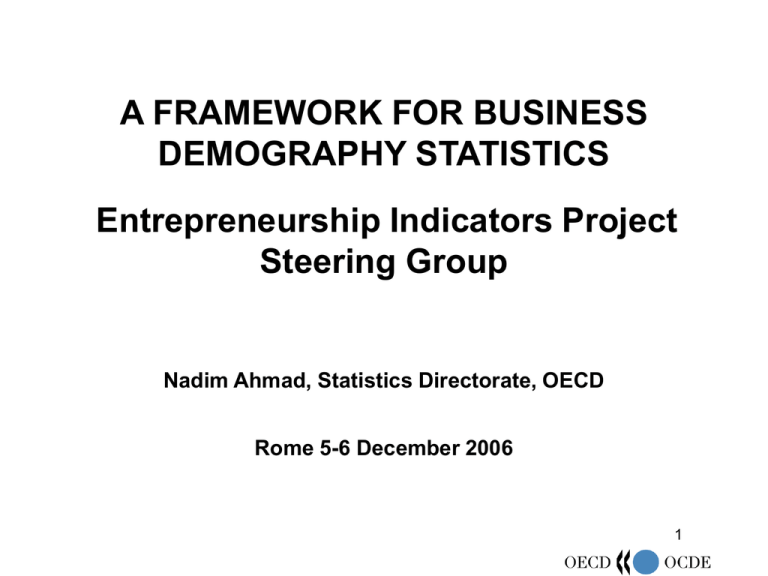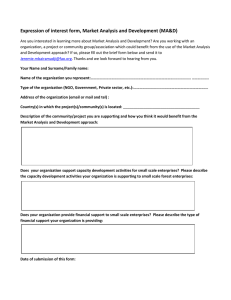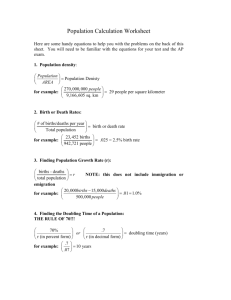A FRAMEWORK FOR BUSINESS DEMOGRAPHY STATISTICS Entrepreneurship Indicators Project Steering Group
advertisement

A FRAMEWORK FOR BUSINESS DEMOGRAPHY STATISTICS Entrepreneurship Indicators Project Steering Group Nadim Ahmad, Statistics Directorate, OECD Rome 5-6 December 2006 1 Background Earlier OECD work established little comparability in international estimates of start-up rates - particularly EU vs ROW (STD/DOC(2006)4) 25% 20% 15% 10% 5% 2000 2001 2002 2 US (BLS) US (SUSB) UK Sweden Spain Slovakia Portugal Norway Netherlands New Zealand Latvia Italy Germany France Finland Denmark Canada Australia 0% Background Further investigations revealed differences and scarcity in other business demography entrepreneurship) indicators – death rates, survival rates and high growth enterprise rates. The case for a framework of concepts and indicators that facilitated international comparisons was clear. 3 The Framework – Main Indicators Statistical Unit – The Enterprise Births – Creations with 1 or more employees and turnover >0 Deaths – Demise of Enterprises with 1 or more employees and turnover > 0 Year t (x-year) Survival Rates – Enterprises born in year t surviving x yrs later (as % of births) High Growth Enterprises – average growth of 20% p/a over 3 yr period (with 10 or more employees). Gazelles (and < 5 yrs) 4 The Framework – Additional Indicators Economic Births – Creations with 2 or more employees and turnover >0 Average (x-year) Survival Rates – Enterprises born in a period surviving x years later (as % of births in period) Employment weighted Births Employment weighted Deaths All rates additionally calculated as % of human working-age population 5 Enterprise - Why? Enterprise – reflects control, where decisions are made and where innovation/R&D is sourced/shared. Choosing Establishments rather than Enterprises can lead to asymmetric treatment of growth depending on location. Important point is to first define the economic region of interest, then the firm. Important to note however that the more you disaggregate a region into sub-regions the higher the total of all sub-region births compared to the regional total (and growth rates can differ too, particularly for the surviving population). 6 Births: 1 or more Employees - Why? Comparability – Many countries do not collect information below this level. – But even those that do, must use some size threshold of ‘significant’ economic activity, which inevitably will differ (PPPs, inflation, exchange rates, administrative ability, informal economy). The issue of size and informality are disproportionately features of micro (self-employed) enterprises. 7 Births: 1 or more Employees - Why? Policy Drivers – Need to recall what analytical/policy purpose is being served: • “Entrepreneurship” – Key is in understanding what makes firms successful, employers, etc and to replicate this success. – High birth rates provide some indication of growth potential. But birth rates that capture all business creations, irrespective of size and growth potential may not be the best indicator for all scenarios. – Policy rarely about increasing ‘self-employment’ per se, statistics of which are readily available via LFS, and which can be affected by nominal status change (employee to self-employed). – Businesses with employees are more meaningful measure 8 Births: 1 or more Employees - Why? Ultimately the question relates to timing: Business births theoretically could be defined as the creation of an idea, registration, the acquisition of assets/location/employees etc, and, so the decision, needs to be based necessarily on a convention. The criteria for the OECD, for this convention, are comparability, economic significance, and facilitating policy. Not to say that ‘1 or more’ measure is perfect. Changes in status from unincorporated to incorporated can impact this concept – hence supplementary indicator recording ‘economic births’ 2 or more’ 9 Corollary Other definitions (deaths, survival rates) follows as corollary of birth and business unit definitions. 10 Growth High Growth Enterprises – All enterprises with average annualised growth of 20% or more p/a over 3 yrs, and with 10 or more employees in the beginning of the period. Gazelles – As above but only for Enterprises < 5 years old. Pragmatic choice for employment (and not turnover) based growth. (Although often used, T/O measures susceptible to inflation, industry differences, etc present difficulties). Investigations on growth continue however with view to establishing complementary definitions that overcome these difficulties. 11 Other Definitions Birth/Death denominators – Enterprise population measures can be problematic. E.g. Transition economies; Industrial consolidation; State owned enterprises (near monopolies) etc. Framework proposes therefore additional indicators based on human populations . 12 Next Steps Framework presented to Eurostat Business Demography Meeting in June 2006. Endorsement of OECD proposal to collect employee births and indicators on growth Eurostat countries asked to test the feasibility of producing these indicators building on the BD information they already collect (all enterprises) with a view to provisional indicators in June 2007. OECD will request data, on a voluntary basis, from non-EU OECD countries starting this year. 13




